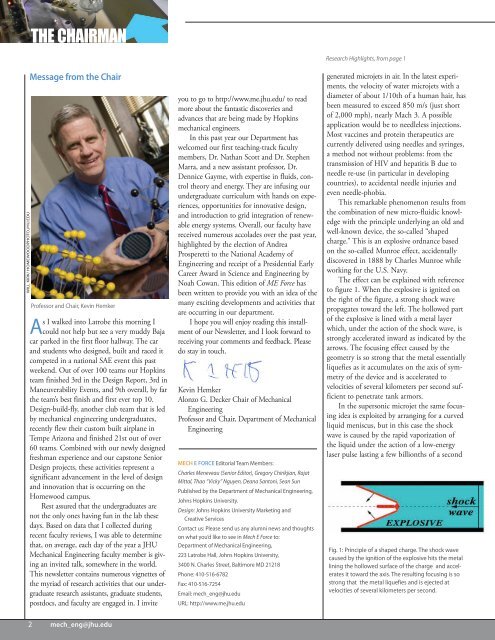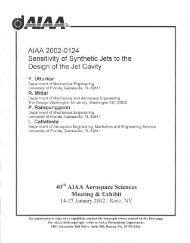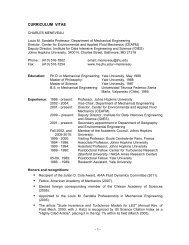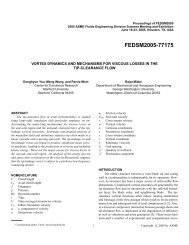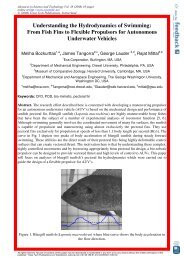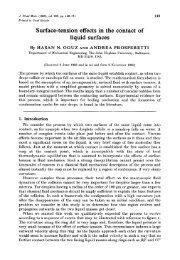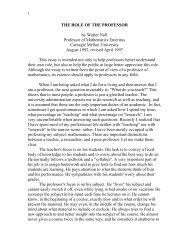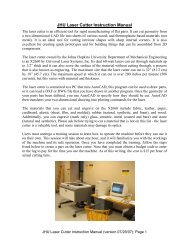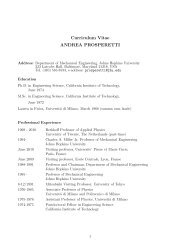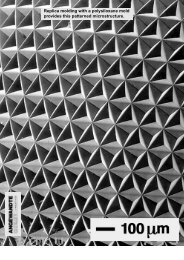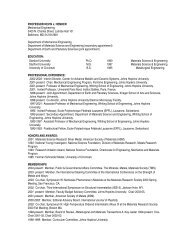Departmental Brochure (PDF) - Mechanical Engineering - Johns ...
Departmental Brochure (PDF) - Mechanical Engineering - Johns ...
Departmental Brochure (PDF) - Mechanical Engineering - Johns ...
You also want an ePaper? Increase the reach of your titles
YUMPU automatically turns print PDFs into web optimized ePapers that Google loves.
The ChairMAN<br />
WILL KIRK/ HOMEWOODPHOTO.JHU.EDU<br />
Message from the Chair<br />
Professor and Chair, Kevin Hemker<br />
As I walked into Latrobe this morning I<br />
could not help but see a very muddy Baja<br />
car parked in the first floor hallway. The car<br />
and students who designed, built and raced it<br />
competed in a national SAE event this past<br />
weekend. Out of over 100 teams our Hopkins<br />
team finished 3rd in the Design Report, 3rd in<br />
Maneuverability Events, and 9th overall, by far<br />
the team’s best finish and first ever top 10.<br />
Design-build-fly, another club team that is led<br />
by mechanical engineering undergraduates,<br />
recently flew their custom built airplane in<br />
Tempe Arizona and finished 21st out of over<br />
60 teams. Combined with our newly designed<br />
freshman experience and our capstone Senior<br />
Design projects, these activities represent a<br />
significant advancement in the level of design<br />
and innovation that is occurring on the<br />
Homewood campus.<br />
Rest assured that the undergraduates are<br />
not the only ones having fun in the lab these<br />
days. Based on data that I collected during<br />
recent faculty reviews, I was able to determine<br />
that, on average, each day of the year a JHU<br />
<strong>Mechanical</strong> <strong>Engineering</strong> faculty member is giving<br />
an invited talk, somewhere in the world.<br />
This newsletter contains numerous vignettes of<br />
the myriad of research activities that our undergraduate<br />
research assistants, graduate students,<br />
postdocs, and faculty are engaged in. I invite<br />
you to go to http://www.me.jhu.edu/ to read<br />
more about the fantastic discoveries and<br />
advances that are being made by Hopkins<br />
mechanical engineers.<br />
In this past year our Department has<br />
welcomed our first teaching-track faculty<br />
members, Dr. Nathan Scott and Dr. Stephen<br />
Marra, and a new assistant professor, Dr.<br />
Dennice Gayme, with expertise in fluids, control<br />
theory and energy. They are infusing our<br />
undergraduate curriculum with hands on experiences,<br />
opportunities for innovative design,<br />
and introduction to grid integration of renewable<br />
energy systems. Overall, our faculty have<br />
received numerous accolades over the past year,<br />
highlighted by the election of Andrea<br />
Prosperetti to the National Academy of<br />
<strong>Engineering</strong> and receipt of a Presidential Early<br />
Career Award in Science and <strong>Engineering</strong> by<br />
Noah Cowan. This edition of ME Force has<br />
been written to provide you with an idea of the<br />
many exciting developments and activities that<br />
are occurring in our department.<br />
I hope you will enjoy reading this installment<br />
of our Newsletter, and I look forward to<br />
receiving your comments and feedback. Please<br />
do stay in touch.<br />
Kevin Hemker<br />
Alonzo G. Decker Chair of <strong>Mechanical</strong><br />
<strong>Engineering</strong><br />
Professor and Chair, Department of <strong>Mechanical</strong><br />
<strong>Engineering</strong><br />
MECH E FORCE Editorial Team Members:<br />
Charles Meneveau (Senior Editor), Gregory Chirikjian, Rajat<br />
Mittal, Thao “Vicky” Nguyen, Deana Santoni, Sean Sun<br />
Published by the Department of <strong>Mechanical</strong> <strong>Engineering</strong>,<br />
<strong>Johns</strong> Hopkins University.<br />
Design: <strong>Johns</strong> Hopkins University Marketing and<br />
Creative Services<br />
Contact us: Please send us any alumni news and thoughts<br />
on what you’d like to see in Mech E Force to:<br />
Department of <strong>Mechanical</strong> <strong>Engineering</strong>,<br />
223 Latrobe Hall, <strong>Johns</strong> Hopkins University,<br />
3400 N. Charles Street, Baltimore MD 21218<br />
Phone: 410-516-6782<br />
Fax: 410-516-7254<br />
Email: mech_eng@jhu.edu<br />
URL: http://www.me.jhu.edu<br />
Research Highlights, from page 1<br />
generated microjets in air. In the latest experiments,<br />
the velocity of water microjets with a<br />
diameter of about 1/10th of a human hair, has<br />
been measured to exceed 850 m/s (just short<br />
of 2,000 mph), nearly Mach 3. A possible<br />
application would be to needleless injections.<br />
Most vaccines and protein therapeutics are<br />
currently delivered using needles and syringes,<br />
a method not without problems: from the<br />
transmission of HIV and hepatitis B due to<br />
needle re-use (in particular in developing<br />
countries), to accidental needle injuries and<br />
even needle-phobia.<br />
This remarkable phenomenon results from<br />
the combination of new micro-fluidic knowledge<br />
with the principle underlying an old and<br />
well-known device, the so-called “shaped<br />
charge.” This is an explosive ordnance based<br />
on the so-called Munroe effect, accidentally<br />
discovered in 1888 by Charles Munroe while<br />
working for the U.S. Navy.<br />
The effect can be explained with reference<br />
to figure 1. When the explosive is ignited on<br />
the right of the figure, a strong shock wave<br />
propagates toward the left. The hollowed part<br />
of the explosive is lined with a metal layer<br />
which, under the action of the shock wave, is<br />
strongly accelerated inward as indicated by the<br />
arrows. The focusing effect caused by the<br />
geometry is so strong that the metal essentially<br />
liquefies as it accumulates on the axis of symmetry<br />
of the device and is accelerated to<br />
velocities of several kilometers per second sufficient<br />
to penetrate tank armors.<br />
In the supersonic microjet the same focusing<br />
idea is exploited by arranging for a curved<br />
liquid meniscus, but in this case the shock<br />
wave is caused by the rapid vaporization of<br />
the liquid under the action of a low-energy<br />
laser pulse lasting a few billionths of a second<br />
Fig. 1: Principle of a shaped charge. The shock wave<br />
caused by the ignition of the explosive hits the metal<br />
lining the hollowed surface of the charge and accelerates<br />
it toward the axis. The resulting focusing is so<br />
strong that the metal liquefies and is ejected at<br />
velocities of several kilometers per second.<br />
2 www.me.jhu.edu<br />
mech_eng@jhu.edu


